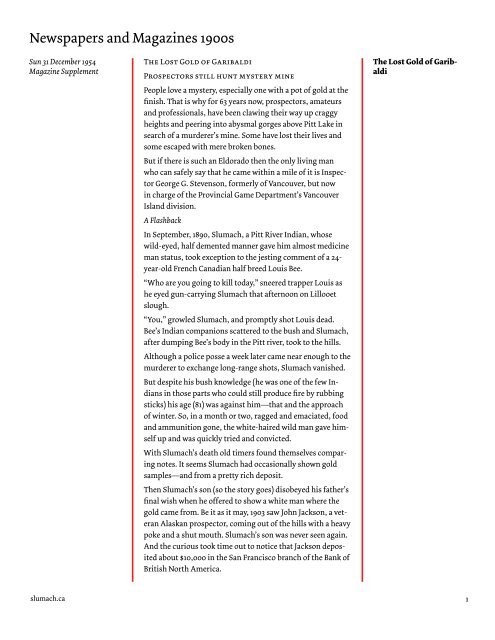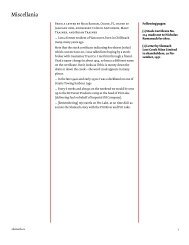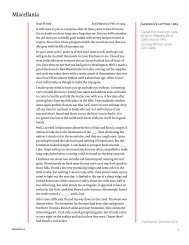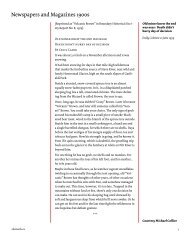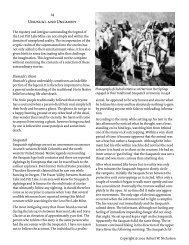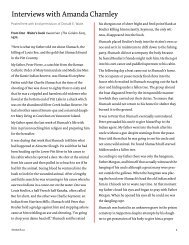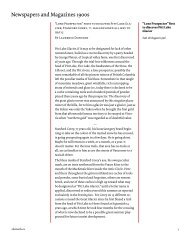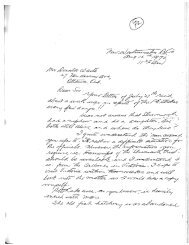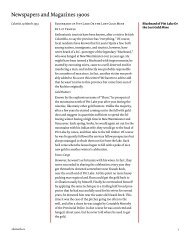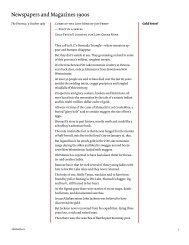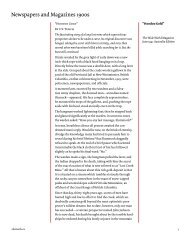The lost gold of Garibaldi, by Cecil Clark, Sun, 31 ... - Slumach
The lost gold of Garibaldi, by Cecil Clark, Sun, 31 ... - Slumach
The lost gold of Garibaldi, by Cecil Clark, Sun, 31 ... - Slumach
- No tags were found...
You also want an ePaper? Increase the reach of your titles
YUMPU automatically turns print PDFs into web optimized ePapers that Google loves.
Newspapers and Magazines 1900s<strong>Sun</strong> <strong>31</strong> December 1954Magazine Supplement<strong>The</strong> Lost Gold <strong>of</strong> <strong>Garibaldi</strong>Prospectors still hunt mystery minePeople love a mystery, especially one with a pot <strong>of</strong> <strong>gold</strong> at thefinish. That is why for 63 years now, prospectors, amateursand pr<strong>of</strong>essionals, have been clawing their way up craggyheights and peering into a<strong>by</strong>smal gorges above Pitt Lake insearch <strong>of</strong> a murderer’s mine. Some have <strong>lost</strong> their lives andsome escaped with mere broken bones.But if there is such an Eldorado then the only living manwho can safely say that he came within a mile <strong>of</strong> it is InspectorGeorge G. Stevenson, formerly <strong>of</strong> Vancouver, but nowin charge <strong>of</strong> the Provincial Game Department’s VancouverIsland division.A FlashbackIn September, 1890, <strong>Slumach</strong>, a Pitt River Indian, whosewild-eyed, half demented manner gave him almost medicineman status, took exception to the jesting comment <strong>of</strong> a 24-year-old French Canadian half breed Louis Bee.“Who are you going to kill today,” sneered trapper Louis ashe eyed gun-carrying <strong>Slumach</strong> that afternoon on Lillooetslough.“You,” growled <strong>Slumach</strong>, and promptly shot Louis dead.Bee’s Indian companions scattered to the bush and <strong>Slumach</strong>,after dumping Bee’s body in the Pitt river, took to the hills.Although a police posse a week later came near enough to themurderer to exchange long-range shots, <strong>Slumach</strong> vanished.But despite his bush knowledge (he was one <strong>of</strong> the few Indiansin those parts who could still produce fire <strong>by</strong> rubbingsticks) his age (81) was against him—that and the approach<strong>of</strong> winter. So, in a month or two, ragged and emaciated, foodand ammunition gone, the white-haired wild man gave himselfup and was quickly tried and convicted.With <strong>Slumach</strong>’s death old timers found themselves comparingnotes. It seems <strong>Slumach</strong> had occasionally shown <strong>gold</strong>samples—and from a pretty rich deposit.<strong>The</strong>n <strong>Slumach</strong>’s son (so the story goes) disobeyed his father’sfinal wish when he <strong>of</strong>fered to show a white man where the<strong>gold</strong> came from. Be it as it may, 1903 saw John Jackson, a veteranAlaskan prospector, coming out <strong>of</strong> the hills with a heavypoke and a shut mouth. <strong>Slumach</strong>’s son was never seen again.And the curious took time out to notice that Jackson depositedabout $10,000 in the San Francisco branch <strong>of</strong> the Bank <strong>of</strong>British North America.<strong>The</strong> Lost Gold <strong>of</strong> <strong>Garibaldi</strong>slumach.ca
Newspapers and Magazines 1900sSold the mapA year or two later, just before his death in Seattle, Jacksonsold or gave a map <strong>of</strong> the claim to a man called Shotwell. <strong>The</strong>original, or copies <strong>of</strong> it, pop up from time to time; and <strong>of</strong>fand on for 509 years they have spurred the seekers over thebolder strewn slopes and ice fields <strong>of</strong> the upper Pitt.Some definitely discouraged all attempts to follow them; andsuch a one was “Volcanic” Brown, a grizzled old discoverer <strong>of</strong>the Volcanic mine in the southeast Kootenay country.One night many years ago, so the story goes, Brown turnedup at the Kootenay hunting lodge <strong>of</strong> four Nelson businessmen. He was tired, but after a couple <strong>of</strong> stiff rums and a hotmeal, garrulously told how he’d once met up with an ailinggranddaughter <strong>of</strong> <strong>Slumach</strong>. Volcanic, being a bit <strong>of</strong> a herbalist,cured her. And in return she gave him a clue as to thelocation <strong>of</strong> her grandfather’s mine.This was the most the taciturn old man told anyone. Later,down at the coast, he visited the headwaters <strong>of</strong> the Pittseason after season. He always brought <strong>gold</strong> but he neverrecorded a claim.Ones he got his toes frozen, amputated some <strong>of</strong> themhimself, and made his way out to Seven Mile Creek where arescue party picked him up. <strong>The</strong>re was no clue as to wherehe’d been. Each year when he came out about the middle <strong>of</strong>September, he checked in at the government hatchery at thehead <strong>of</strong> Pitt Lake.In September, 1930, he didn’t appear and in a month or so asearch party went in. In it were Game Warden (now inspector)George Stevenson, provincial constable Eugene (“Spud”)Murphy, and Roy and Bill McMaster, experienced trapperswho knew old Volcanic.A tough tripRecalling the trip, Stevenson, a wiry, bush-wise veteran <strong>of</strong> 25years with the Game Department, says it was the toughest heever undertook. In the 27-day search Stevenson—never packingmuch excess weight—<strong>lost</strong> 13 pounds.It was early November when they went in, an almost impossibleventure save for skilled men. Early on the way Murphyfell victim <strong>of</strong> injury and Bill McMaster helped him return.Stevenson and Roy McMaster went ahead.From the head <strong>of</strong> Pitt lake the part went up to the headwaters<strong>of</strong> Seven Mile Creek, then across the divide to Homesteadglacier. Across the mile-and-a-half glacier they struck whattrappers call Porcupine valley, and making their way up toslumach.ca
Newspapers and Magazines 1900sthe timberline, started across the seven-mile Stave Glacier.Where the Stave river is born they found Volcanic Brownslast camp.<strong>The</strong>re was deep snow on the ground and plenty in the air. Atone spot they were snowbound for five days and on HomesteadGlacier it took all <strong>of</strong> one day to make 1,200 feet.Under the deep snow Brown’s camp was found <strong>by</strong> accident.Whiskey Jacks squabbling in a snow-laden tree attractedStevenson’s attention. Yanking the branches loose <strong>of</strong> snow hesaw a blackened piece <strong>of</strong> frozen bear meat wired to a banch.Probing around they discovered a collapsed pup tent, somecooking utensils, a single barrelled shotgun, and a notebookwith here and there herb remedies written in it. Anothersmall object attracted attention: a screw-top glass jar full<strong>of</strong> coarse <strong>gold</strong>. Gold that had been hammered out <strong>of</strong> a solidvein, for it still bore traces <strong>of</strong> quartz.<strong>The</strong> sole linkBrown was never found. Of the pair that found the camp, RoyMcMaster is now dead. Which leaves George Stevenson solelink with Volcanic Brown’s possible solution <strong>of</strong> the <strong>lost</strong> mine.Insp. Stevenson, a family man, hasn’t felt like pursuing thewill-o’-the-wisp mine, being much too busy with his governmentalcareer—but he had some substantial <strong>of</strong>fers <strong>of</strong> backingif he ever wants to take up where Volcanic Brown left <strong>of</strong>f.slumach.ca


